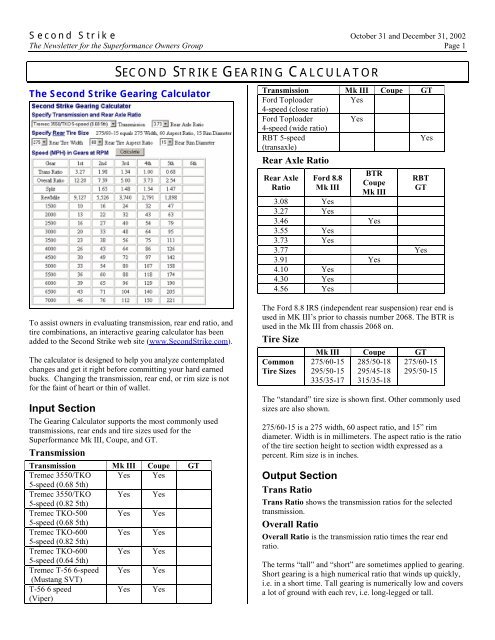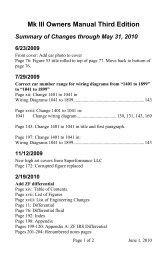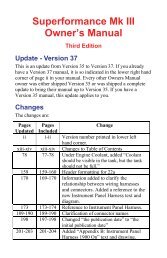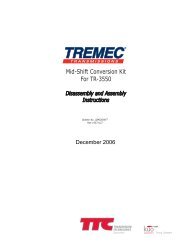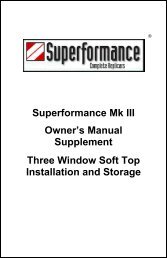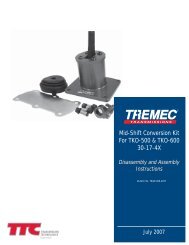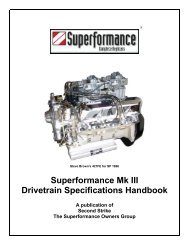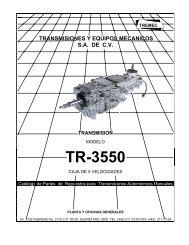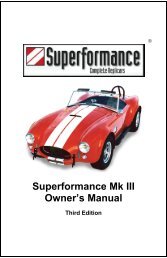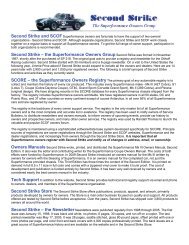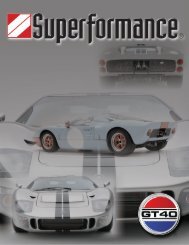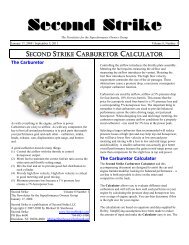SECOND STRIKE GEARING CALCULATOR - Second Strike - the ...
SECOND STRIKE GEARING CALCULATOR - Second Strike - the ...
SECOND STRIKE GEARING CALCULATOR - Second Strike - the ...
Create successful ePaper yourself
Turn your PDF publications into a flip-book with our unique Google optimized e-Paper software.
<strong>Second</strong> <strong>Strike</strong> October 31 and December 31, 2002<br />
The Newsletter for <strong>the</strong> Superformance Owners Group Page 1<br />
<strong>SECOND</strong> <strong>STRIKE</strong> <strong>GEARING</strong> <strong>CALCULATOR</strong><br />
The <strong>Second</strong> <strong>Strike</strong> Gearing Calculator<br />
To assist owners in evaluating transmission, rear end ratio, and<br />
tire combinations, an interactive gearing calculator has been<br />
added to <strong>the</strong> <strong>Second</strong> <strong>Strike</strong> web site (www.<strong>Second</strong><strong>Strike</strong>.com).<br />
The calculator is designed to help you analyze contemplated<br />
changes and get it right before committing your hard earned<br />
bucks. Changing <strong>the</strong> transmission, rear end, or rim size is not<br />
for <strong>the</strong> faint of heart or thin of wallet.<br />
Input Section<br />
The Gearing Calculator supports <strong>the</strong> most commonly used<br />
transmissions, rear ends and tire sizes used for <strong>the</strong><br />
Superformance Mk III, Coupe, and GT.<br />
Transmission<br />
Transmission Mk III Coupe GT<br />
Tremec 3550/TKO<br />
5-speed (0.68 5th)<br />
Yes Yes<br />
Tremec 3550/TKO<br />
5-speed (0.82 5th)<br />
Yes Yes<br />
Tremec TKO-500<br />
5-speed (0.68 5th)<br />
Yes Yes<br />
Tremec TKO-600<br />
5-speed (0.82 5th)<br />
Yes Yes<br />
Tremec TKO-600<br />
5-speed (0.64 5th)<br />
Yes Yes<br />
Tremec T-56 6-speed Yes Yes<br />
(Mustang SVT)<br />
T-56 6 speed<br />
(Viper)<br />
Yes Yes<br />
Transmission Mk III Coupe GT<br />
Ford Toploader<br />
4-speed (close ratio)<br />
Yes<br />
Ford Toploader<br />
4-speed (wide ratio)<br />
Yes<br />
RBT 5-speed<br />
(transaxle)<br />
Yes<br />
Rear Axle Ratio<br />
Rear Axle<br />
Ratio<br />
Ford 8.8<br />
Mk III<br />
BTR<br />
Coupe<br />
Mk III<br />
RBT<br />
GT<br />
3.08 Yes<br />
3.27 Yes<br />
3.46 Yes<br />
3.55 Yes<br />
3.73 Yes<br />
3.77 Yes<br />
3.91 Yes<br />
4.10 Yes<br />
4.30 Yes<br />
4.56 Yes<br />
The Ford 8.8 IRS (independent rear suspension) rear end is<br />
used in MK III’s prior to chassis number 2068. The BTR is<br />
used in <strong>the</strong> Mk III from chassis 2068 on.<br />
Tire Size<br />
Common<br />
Tire Sizes<br />
Mk III Coupe GT<br />
275/60-15<br />
295/50-15<br />
335/35-17<br />
285/50-18<br />
295/45-18<br />
315/35-18<br />
275/60-15<br />
295/50-15<br />
The “standard” tire size is shown first. O<strong>the</strong>r commonly used<br />
sizes are also shown.<br />
275/60-15 is a 275 width, 60 aspect ratio, and 15” rim<br />
diameter. Width is in millimeters. The aspect ratio is <strong>the</strong> ratio<br />
of <strong>the</strong> tire section height to section width expressed as a<br />
percent. Rim size is in inches.<br />
Output Section<br />
Trans Ratio<br />
Trans Ratio shows <strong>the</strong> transmission ratios for <strong>the</strong> selected<br />
transmission.<br />
Overall Ratio<br />
Overall Ratio is <strong>the</strong> transmission ratio times <strong>the</strong> rear end<br />
ratio.<br />
The terms “tall” and “short” are sometimes applied to gearing.<br />
Short gearing is a high numerical ratio that winds up quickly,<br />
i.e. in a short time. Tall gearing is numerically low and covers<br />
a lot of ground with each rev, i.e. long-legged or tall.
<strong>Second</strong> <strong>Strike</strong> October 31 and December 31, 2002<br />
The Newsletter for <strong>the</strong> Superformance Owners Group Page 2<br />
Split<br />
Split is <strong>the</strong> ratio of <strong>the</strong> previous gear to this gear, a ratio of<br />
ratios if you will. For <strong>the</strong> transmission to “feel right”, <strong>the</strong> split<br />
should be <strong>the</strong> same or drop evenly from one gear to <strong>the</strong> next.<br />
If <strong>the</strong> split drops from gear to gear <strong>the</strong>n goes back up as with<br />
<strong>the</strong> standard Tremec 3550 ratios, you will notice a “gap” when<br />
you shift. The standard Tremec is really a 4-speed with a tall<br />
overdrive 5th gear for cruising.<br />
The split is a good measure of gear spacing. For a split of<br />
1.31, <strong>the</strong> engine speed will go up 31% if you downshift, say<br />
from 3500 rpm to 4500 rpm. The tighter (smaller) <strong>the</strong> split,<br />
<strong>the</strong> less <strong>the</strong> engine speed changes when you shift. The split<br />
requirement is determined by <strong>the</strong> width of <strong>the</strong> power band.<br />
Engines with very narrow power bands need tight splits to<br />
keep <strong>the</strong> engine operating in <strong>the</strong> power band. Tight splits<br />
mean more gears to cover <strong>the</strong> same speed range and more<br />
gears means more time lost shifting. Engines with broad<br />
power bands work well with wider splits.<br />
For <strong>the</strong> types of engines we are looking at, a “close ratio”<br />
transmission will have an average split in <strong>the</strong> 1.30 range. A<br />
“wide ratio” transmission will have an average split in <strong>the</strong> 1.40<br />
to 1.50 range.<br />
In some gearboxes <strong>the</strong> splits are all <strong>the</strong> same. This purely<br />
geometric arrangement provides <strong>the</strong> same rpm change in every<br />
gear when you shift. So <strong>the</strong> optimum shift point is <strong>the</strong> same<br />
for each gear.<br />
In some gearboxes, <strong>the</strong> splits decrease ra<strong>the</strong>r uniformly. In<br />
this case, <strong>the</strong> gears get tighter as you go up. This has a very<br />
natural feel to it and is <strong>the</strong> most common gearbox design.<br />
However, <strong>the</strong> optimum shift point will be different for each<br />
gear.<br />
In some cases, <strong>the</strong> split jumps up on <strong>the</strong> top ratio. This<br />
indicates an overdrive gear for highway cruising. The<br />
increase in <strong>the</strong> split is usually easily detected as a bog when<br />
shifting into top gear.<br />
Rev/Mile<br />
Rev/Mile is <strong>the</strong> engine revolutions per mile, which is <strong>the</strong> same<br />
as engine rpm at 60 mph. It is <strong>the</strong> best comparison figure for<br />
overall gearing since it includes transmission ratio, rear end<br />
ratio, and tire size.<br />
The following observations are for a light car with a large<br />
powerful engine. Different observations would apply to o<strong>the</strong>r<br />
type vehicles.<br />
The rev/mile in first gear is a good measure of how easy <strong>the</strong><br />
car is to launch and drive in traffic. If <strong>the</strong> rev/mile in first is<br />
much below 7000, <strong>the</strong> car will require noticeable clutch<br />
slippage to get under way in traffic and when driving in slow<br />
traffic. First gear for this combination is too tall for<br />
comfortable dual-purpose use. A rev/mile in first of 7500 is<br />
workable if <strong>the</strong> engine is tractable. A rev/mile in first in <strong>the</strong><br />
8000 to 9000 range is easy to start and drive in traffic. A<br />
rev/mile over 9000 will seem too short. First gear will not be a<br />
useful performance gear. Traction will be a problem. You<br />
won’t stay in first very long before it is time to shift.<br />
The rev/mile in top gear is a good measure of how<br />
comfortably <strong>the</strong> car will cruise on <strong>the</strong> highway. If it is too<br />
low, <strong>the</strong> engine will run roughly or buck at cruising speeds. If<br />
it is too high, <strong>the</strong> engine speed will be wearing on both <strong>the</strong><br />
engine and <strong>the</strong> passengers. A rev/mile in top gear of 1500 is<br />
possible for a tractable high performance engine, typically<br />
with an electronic engine management system. For high<br />
performance carbureted engines, something in <strong>the</strong> 1800 to<br />
2000 range is a better target.<br />
Speed in Gears at RPM<br />
Speed in Gears at RPM. Following Revs/Mile is a chart of<br />
speed in each gear in 500 rpm increments.<br />
This section will show you how slow you can go in each gear<br />
at a given engine speed, say 1500 or 2000 rpm. This is a good<br />
measure of drivability. Consider <strong>the</strong> following example for a<br />
Mk III with a TKO II transmission, 3.08 rear end and 275/60-<br />
15 tires.<br />
Gear 1st 2nd 3rd 4th 5th<br />
1500 12 20 29 39 48<br />
2000 16 26 39 52 63<br />
If <strong>the</strong> minimum drivable rpm is 2000 rpm, <strong>the</strong>n a 25 mph<br />
speed limit requires 1 st gear, 35 requires 2 nd , 45 requires 3 rd ,<br />
and 55 requires 4 th . Tuning <strong>the</strong> engine for a minimum drivable<br />
rpm of 1500 rpm means that 25 requires 2 nd , 35 requires 3 rd ,<br />
45 requires 4 th , and 55 requires 5 th . Improving drivability<br />
allows cruising in one taller gear at each speed limit.<br />
This section will also show you how fast you can go in <strong>the</strong><br />
gears. Considering <strong>the</strong> same example:<br />
Gear 1st 2nd 3 rd 4th 5th<br />
6000 48 79 117 156 190<br />
6500 52 85 126 169 206<br />
With this gearing, <strong>the</strong> car will easily exceed 150 mph in 4 th<br />
gear. Above 150 mph, aerodynamic stability is an issue for<br />
any blunt car, so it is a reasonable upper limit even on <strong>the</strong><br />
track for safety reasons. Any gearing that will get you to 150<br />
in 4 th means that 5 th is no longer needed as performance gear<br />
and will be used for highway cruising only.<br />
Gearing<br />
In this sense, “gearing” is anything that affects <strong>the</strong> relationship<br />
between engine speed and car speed. This includes <strong>the</strong><br />
transmission ratios, <strong>the</strong> rear end ratio, and <strong>the</strong> tire size. From<br />
a performance perspective, <strong>the</strong> primary objective is to keep <strong>the</strong><br />
engine operating in <strong>the</strong> power band from rest all <strong>the</strong> way to <strong>the</strong><br />
maximum speed.<br />
For a street machine or a dual-purpose road/track machine,<br />
<strong>the</strong>re are typically o<strong>the</strong>r objectives as well. For example, <strong>the</strong>
<strong>Second</strong> <strong>Strike</strong> October 31 and December 31, 2002<br />
The Newsletter for <strong>the</strong> Superformance Owners Group Page 3<br />
car should cruise comfortably at minimum engine speed on <strong>the</strong><br />
highway. This reduces noise, engine wear, and fuel<br />
consumption, and improves cruising comfort and pleasure. In<br />
addition, <strong>the</strong> car should be able to get underway and manage<br />
slow traffic without excessive clutch slippage.<br />
In <strong>the</strong> early years, <strong>the</strong> 351 cubic Windsor was <strong>the</strong> most<br />
popular engine and <strong>the</strong> “standard” gearing (Tremec 3550 and<br />
3.73 rear end) was <strong>the</strong> right choice for many owners.<br />
However, with <strong>the</strong> large displacement engines, it is easy to<br />
overpower <strong>the</strong> tires in first and frequently second gear with <strong>the</strong><br />
standard gearing. The ever present big blocks and <strong>the</strong> growing<br />
popularity of large displacement small blocks have caused a<br />
number of new and existing owners to revisit <strong>the</strong> standard<br />
gearing.<br />
Selecting <strong>the</strong> proper gearing is part engineering (running <strong>the</strong><br />
numbers) and part experience (seat of <strong>the</strong> pants). For running<br />
<strong>the</strong> numbers, I have over <strong>the</strong> years analyzed <strong>the</strong> gear ratios in<br />
virtually every high performance manual transmission<br />
produced in <strong>the</strong> USA and have a pretty good feel for what <strong>the</strong><br />
designer was trying to accomplish. I also have developed a<br />
ra<strong>the</strong>r sophisticated performance simulator that I use to<br />
evaluate alternatives. For seat of <strong>the</strong> pants, I have driven a fair<br />
number of cars over <strong>the</strong> years with 4-speeds, 5-speeds, and 6speeds,<br />
and a number of rear end ratios. Even better, I have<br />
<strong>the</strong> Olthoff’s track and customer car experiences to draw on.<br />
Ford Toploader 4-Speed and 3.55<br />
The Ford Toploader Close Ratio with a 3.55 rear end ratio<br />
illustrated in <strong>the</strong> chart below was a standard combination for<br />
<strong>the</strong> original 427 Cobra. It is representative of “period correct”<br />
gearing. The data shown is for <strong>the</strong> close ratio version of <strong>the</strong><br />
Ford Toploader. The splits are close and decrease only<br />
slightly. This is basically a geometric gearbox.<br />
The rev/mile in first is just above 6000. Based on actual<br />
driving experience with a 427/Toploader combination, it<br />
requires a good bit of clutch slippage to get underway and<br />
when driving in slow traffic. First gear for this combination is<br />
too tall for comfortable street or dual-purpose use.<br />
Gear 1st 2nd 3rd 4th<br />
Trans Ratio 2.32 1.69 1.29 1<br />
Overall Ratio 8.24 6 4.58 3.55<br />
Split 1.37 1.31 1.29<br />
Rev/Mile 6,163 4,489 3,427 2,656<br />
1500 15 20 26 34<br />
2000 19 27 35 45<br />
2500 24 33 44 56<br />
3000 29 40 53 68<br />
3500 34 47 61 79<br />
4000 39 53 70 90<br />
4500 44 60 79 102<br />
5000 49 67 88 113<br />
5500 54 74 96 124<br />
6000 58 80 105 136<br />
6500 63 87 114 147<br />
The rev/mile in fourth is over 2600. Again, experience<br />
indicates that this is a bit high for highway cruising and will<br />
be taxing on long trips at highway speeds. Fourth gear is too<br />
short.<br />
So what is <strong>the</strong> point of gearing combination with a tall first<br />
and short fourth? It works well for road courses where you<br />
only launch once and <strong>the</strong> top speeds are limited by layout. The<br />
close ratios do help <strong>the</strong> driver find <strong>the</strong> right gear for each<br />
corner on <strong>the</strong> course. However, <strong>the</strong>y were not always <strong>the</strong> hot<br />
ticket for <strong>the</strong> street or even for drag racing.<br />
One of <strong>the</strong> more successful drag racers in <strong>the</strong> 1960s, I believe<br />
it was Hayden Proffit, discovered that big engines with broad<br />
power bands lost time shifting extra gears. He went back to a<br />
3-speed and kicked some 4-speed b***. He was diggin’ while<br />
<strong>the</strong>y were rowin’ <strong>the</strong> gearbox.<br />
Tremec 3550 5-Speed and 3.73<br />
The Tremec 3550 and its big bro<strong>the</strong>r <strong>the</strong> TKO share <strong>the</strong> same<br />
relatively wide ratios. The splits drop progressively through<br />
4th gear <strong>the</strong>n jump up again in 5th. This jump is typical for<br />
overdrive gears. It can easily be detected when running<br />
through <strong>the</strong> gears as a bog when shifting into fifth. Like its<br />
baby bro<strong>the</strong>r, <strong>the</strong> T-5 used in Mustangs, <strong>the</strong> Tremec 3550<br />
ratios are designed as a 4-speed for performance work plus a<br />
tall fifth for highway cruising - a 4+1 if you will.<br />
In my driving experience with SP218, <strong>the</strong> Tremec 3550<br />
transmission and 3.73 rear end were well suited to its 357<br />
cubic inch Windsor engine. First gear at a little over 9000<br />
rev/mile launched <strong>the</strong> car comfortably with minimum clutch<br />
slippage and worked well in slow traffic. Although it would<br />
fry <strong>the</strong> tires in first if provoked, giving <strong>the</strong> car a fraction of a<br />
second to settle back on its haunches before applying<br />
maximum power allowed <strong>the</strong> tires to really hook up and<br />
produce all <strong>the</strong> acceleration <strong>the</strong> tires could handle. Just about<br />
a perfect match.<br />
Gear 1st 2nd 3rd 4th 5th<br />
Trans Ratio 3.27 1.98 1.34 1.00 0.68<br />
Overall Ratio 12.2 7.39 5.00 3.73 2.54<br />
Split 1.65 1.48 1.34 1.47<br />
Rev/Mile 9,127 5,526 3,740 2,791 1,898<br />
1500 10 16 24 32 47<br />
2000 13 22 32 43 63<br />
2500 16 27 40 54 79<br />
3000 20 33 48 64 95<br />
3500 23 38 56 75 111<br />
4000 26 43 64 86 126<br />
4500 30 49 72 97 142<br />
5000 33 54 80 107 158<br />
5500 36 60 88 118 174<br />
6000 39 65 96 129 190<br />
6500 43 71 104 140 205
<strong>Second</strong> <strong>Strike</strong> October 31 and December 31, 2002<br />
The Newsletter for <strong>the</strong> Superformance Owners Group Page 4<br />
<strong>Second</strong>, third, and fourth provided all <strong>the</strong> gears needed for<br />
track work. Fourth at 129 mph at 6000 rpm was just a bit<br />
short for <strong>the</strong> longer straightaways. I did overspeed to 140 at<br />
6500, but that was not a good idea as it turned out. The<br />
overdrive fifth provided comfortable cruising at about 1900<br />
rpm at 60 mph. It would be a useful interstate highway gear<br />
for speeds over 65 mph even for raucous engines that don’t<br />
run well below 2000 rpm.<br />
Tremec T-56 6-Speed and 3.73<br />
The Borg-Warner (now Tremec) T-56 has been used in a<br />
number of high performance cars including <strong>the</strong> Corvette,<br />
Camero, Firebird, Viper, and <strong>the</strong> SVT Mustangs. There are<br />
many ratios available for this transmission. The ratios shown<br />
are for <strong>the</strong> SVT Mustang.<br />
The SVT Mustang splits show evenly spaced gears (constant<br />
split) up through fourth gear. Fifth and sixth are somewhat<br />
more closely spaced. Fifth is a performance gear – 161 mph at<br />
6000 rpm is well within <strong>the</strong> performance envelope of larger<br />
engines. Sixth is a cruising overdrive.<br />
At a bit over 8000 rev/mile in first, <strong>the</strong> car will work well in<br />
traffic. At just over 1700 at 60 mph in sixth, it will cruise<br />
comfortably on <strong>the</strong> highway.<br />
This is a good combination with a gear for every purpose.<br />
There are a few things to consider if you are thinking about a<br />
T-56.<br />
• At 129 pounds, <strong>the</strong>T-56 is 29 pounds heavier that <strong>the</strong><br />
3550.<br />
• It is a good bit more expensive than <strong>the</strong> 3550.<br />
• The T-56 requires cutting and welding modifications to<br />
<strong>the</strong> transmission cross member to install.<br />
• I have driven a number of cars with <strong>the</strong> T-56 6-speed. It<br />
seems to me to have one more gear than a small car with<br />
a big engine needs. This is subjective of course.<br />
Gear 1st 2nd 3rd 4th 5th 6th<br />
Trans Ratio 2.97 2.07 1.43 1.00 0.80 0.62<br />
Overall Ratio 11.08 7.72 5.33 3.73 2.98 2.31<br />
Split 1.43 1.45 1.43 1.25 1.29<br />
Rev/Mile 8,289 5,777 3,991 2,791 2,233 1,730<br />
1500 11 16 23 32 40 52<br />
2000 14 21 30 43 54 69<br />
2500 18 26 38 54 67 87<br />
3000 22 31 45 64 81 104<br />
3500 25 36 53 75 94 121<br />
4000 29 42 60 86 107 139<br />
4500 33 47 68 97 121 156<br />
5000 36 52 75 107 134 173<br />
5500 40 57 83 118 148 191<br />
6000 43 62 90 129 161 208<br />
6500 47 68 98 140 175 225<br />
Tremec 3550 TKO II and 3.08<br />
I did a good bit of engineering and seat of <strong>the</strong> pants work in<br />
selecting <strong>the</strong> drive train to backup <strong>the</strong> RDI 427 prototype.<br />
These are my opinions, of course. O<strong>the</strong>rs will reach o<strong>the</strong>r<br />
conclusions, and that is as it should be.<br />
Starting with <strong>the</strong> tires, I decided long ago to stick with <strong>the</strong><br />
standard 60 series 15 inch tires. I like <strong>the</strong> original looks. And<br />
I don’t want more traction. More traction subjects everything<br />
to higher loads, which in turn accelerates wear and breakage<br />
on <strong>the</strong> car and on <strong>the</strong> aging driver. So I will just slide around<br />
<strong>the</strong> corners with a big grin and you are welcome catch me if<br />
you can.<br />
For <strong>the</strong> transmission, I selected <strong>the</strong> recently introduced<br />
Tremec 3550 TKO II. The TKO has a higher torque capacity,<br />
needed for <strong>the</strong> higher torque 427. The II has a 0.82 close ratio<br />
fifth gear that makes it a true 5-speed instead of a 4+1. I<br />
selected it over <strong>the</strong> T-56 for a number of reasons. Since this<br />
exercise is as much for “us” as it is for me, I wanted to make a<br />
choice that was representative of what o<strong>the</strong>r owners were<br />
doing. Cost, weight, and ease of installation were all factors.<br />
And I felt that 5 gears was <strong>the</strong> right number. Time spent<br />
shifting gears is time not accelerating. A light car with a big<br />
engine and a broad power band just doesn’t need a lot of<br />
gears, in my opinion.<br />
In selecting <strong>the</strong> rear end ratio, I had two objectives. First, I<br />
wanted to avoid overpowering <strong>the</strong> tires in second gear.<br />
(Overpowering in first is unavoidable.) <strong>Second</strong>, I wanted an<br />
overall fifth gear that would cruise comfortably on <strong>the</strong><br />
highway.<br />
As a passenger in a 514 with a 3.73 rear end, I was really<br />
impressed with its ability to light up <strong>the</strong> tires in second at will<br />
by simply rolling on <strong>the</strong> throttle. If fact, I shredded my shorts.<br />
Awesome indeed. But from a practical standpoint, it is a sure<br />
sign of too much gear in second.<br />
Looking at rear end ratios, all of <strong>the</strong> available rear-end ratios<br />
were evaluated in <strong>the</strong> performance simulator and produced<br />
about <strong>the</strong> same acceleration.<br />
Ratio Quarter Mile<br />
3.73 11.76 at 128.81<br />
3.55 11.72 at 128.30<br />
3.27 11.65 at 127.40<br />
3.08 11.60 at 126.85<br />
A 20% change in gearing produced a 1% change in elapsed<br />
time and a 2% change in terminal speed. Essentially no<br />
difference. The reason is simple. If a car has enough power<br />
to overpower <strong>the</strong> tires in first gear, <strong>the</strong>n <strong>the</strong> rear end ratio<br />
has little effect on acceleration performance.<br />
Before you scratch your head, an explanation is in order.<br />
Looking at <strong>the</strong> physics, thrust accelerates <strong>the</strong> car. Thrust is<br />
equal to power divided by speed. For powerful cars, low
<strong>Second</strong> <strong>Strike</strong> October 31 and December 31, 2002<br />
The Newsletter for <strong>the</strong> Superformance Owners Group Page 5<br />
speed thrust is limited by available traction. So <strong>the</strong> initial<br />
acceleration is determined by available traction and after that<br />
acceleration is determined by horsepower. As long as <strong>the</strong><br />
engine is in <strong>the</strong> power band, <strong>the</strong> car is accelerating as quickly<br />
as it can, regardless of gearing.<br />
The “3.73” and 3.08” thrust curves show <strong>the</strong> available thrust<br />
for those rear end ratios. The “Traction Limit” curve shows<br />
<strong>the</strong> traction limited thrust. Tires, weight, weight distribution,<br />
and dynamic weight transfer determine <strong>the</strong> traction limit. Any<br />
thrust above <strong>the</strong> traction limit is lost to wheel spin. So while<br />
<strong>the</strong> 3.73 rear end does generate more thrust in first, it is over<br />
(way over) <strong>the</strong> traction limit, so it cannot be used. The 3.08<br />
rear end also exceeds <strong>the</strong> traction limit, so in reality <strong>the</strong>y<br />
provide <strong>the</strong> same traction limited thrust up to about 65 mph.<br />
Above that, both ratios are fully hooked up and both engines<br />
are operating in <strong>the</strong> maximum power band, so <strong>the</strong> thrust is<br />
again equal. Since both rear ends have <strong>the</strong> same thrust curve<br />
from 0 to 180 mph, <strong>the</strong>y have <strong>the</strong> same acceleration.<br />
The overall gearing chart following gives ano<strong>the</strong>r perspective.<br />
The traction limit is an overall ratio of just above 6.0. Any<br />
torque multiplication (overall gear ratio) above that is lost in<br />
wheel spin. The 3.73 rear end exceeds this limit in both first<br />
and second gear, meaning that <strong>the</strong> lower gearing of <strong>the</strong> 3.73<br />
cannot be used fully until third gear. The 3.08 rear end also<br />
exceeds <strong>the</strong> traction limit by quite a bit in first, but is right on<br />
<strong>the</strong> money in second. So up until about 70 mph, both ratios<br />
are above or at <strong>the</strong> traction limit, and <strong>the</strong>refore equal. Above<br />
70 mph, <strong>the</strong> 3.08 has lower torque multiplication in every<br />
gear, but can stay in a lower gear at higher speeds. At 80 mph<br />
for example, <strong>the</strong> 3.08 is still in second and has a higher overall<br />
gearing than <strong>the</strong> 3.73, which is in third at that speed. The<br />
advantage changes with each shift, but on average it equals<br />
out.<br />
A few notes…<br />
• There is no point in taking <strong>the</strong> excessive thrust out of<br />
first gear with fur<strong>the</strong>r reductions in <strong>the</strong> rear end ratio. It<br />
will make <strong>the</strong> first and fifth gearing too tall for dualpurpose<br />
use.<br />
• For lesser cars without <strong>the</strong> ability to overpower <strong>the</strong> tires,<br />
gearing does matter. A higher numerical ratio will<br />
produce better acceleration. But not with our cars.<br />
• Yes, in a third gear roll-on, <strong>the</strong> car with <strong>the</strong> higher<br />
numerical rear end ratio will win. But in a “you pick <strong>the</strong><br />
gear that works for you” roll-on, it is a dead heat every<br />
time.<br />
• Transmission and rear end gearing are not a significant<br />
factor in overall acceleration performance of this car<br />
with this engine. Gearing selection is more a matter of<br />
personal preference and comfort for <strong>the</strong> intended use.<br />
Here are <strong>the</strong> numbers for <strong>the</strong> TKO II and 3.08.<br />
Gear 1st 2nd 3rd 4th 5th<br />
Trans Ratio 3.27 1.98 1.34 1 0.82<br />
Overall Ratio 10.07 6.1 4.13 3.08 2.53<br />
Split 1.65 1.48 1.34 1.22<br />
Rev/Mile 7,536 4,563 3,088 2,305 1,890<br />
1500 12 20 29 39 48<br />
2000 16 26 39 52 63<br />
2500 20 33 49 65 79<br />
3000 24 39 58 78 95<br />
3500 28 46 68 91 111<br />
4000 32 53 78 104 127<br />
4500 36 59 87 117 143<br />
5000 40 66 97 130 159<br />
5500 44 72 107 143 175<br />
6000 48 79 117 156 190<br />
6500 52 85 126 169 206<br />
7000 56 92 136 182 222
<strong>Second</strong> <strong>Strike</strong> October 31 and December 31, 2002<br />
The Newsletter for <strong>the</strong> Superformance Owners Group Page 6<br />
The 7,536 rev/mile in first is about as low as I would want to<br />
go. It takes some clutch slip to get started and is a bit high in<br />
traffic with a radical cam. Bob Olthoff felt that a 3.27 rear end<br />
would have been a better match with <strong>the</strong> prototype engine and<br />
I am inclined to agree. Hopefully with <strong>the</strong> planned cam<br />
change, <strong>the</strong> 3.08 will work as expected.<br />
The rev/mile in fifth is 1,890, <strong>the</strong> same as <strong>the</strong> standard 3550<br />
with 0.68 fifth and 3.73 rear end. This is a good target for<br />
highway cruising.<br />
Observe that unlike <strong>the</strong> standard 3550, <strong>the</strong> fifth gear split is in<br />
a nice progression with <strong>the</strong> rest of <strong>the</strong> gears. It feels like a true<br />
5-speed when driven.<br />
The change in rear end ratio brought <strong>the</strong> speed in fourth up<br />
from 129 to 156 at 6000 rpm. Even with <strong>the</strong> increase in<br />
displacement and horsepower, it is unlikely that I will<br />
personally ever see fifth on a track.<br />
Updates<br />
Since this article was originally published in 2002, much has<br />
changed.<br />
• The Superformance Coupe has been announced<br />
• The Superformance GT has been announced.<br />
• Tremec announced <strong>the</strong> new TKO-500 and TKO-600<br />
5-speeds and dropped <strong>the</strong> familiar 3550 and TKO.<br />
• From car 2068 on <strong>the</strong> Mk III began using <strong>the</strong> same basic<br />
rear end as <strong>the</strong> Coupe with <strong>the</strong> same 3.46 ratio.<br />
The Gearing Calculator has been updated to incorporate all<br />
<strong>the</strong>se changes.<br />
Suggestions<br />
Mk III with Ford 3.73 Rear End<br />
With <strong>the</strong> Ford IRS (independent rear suspension) 8.8 rear end<br />
used prior to chassis 2068, you have a large choice of off-<strong>the</strong>shelf<br />
ratios from Ford Racing to consider.<br />
The original gearing article stimulated a lot of owners to reevaluate<br />
<strong>the</strong>ir gearing. The <strong>the</strong>n standard 3.73 rear end ratio<br />
was OK for a standard displacement 351, but was too short for<br />
<strong>the</strong> growing number of 351 strokers and <strong>the</strong> 427 and 460 big<br />
blocks, rendering first gear all but useless.<br />
Based on <strong>the</strong>se changes and quite a few conversations with<br />
owners re-evaluating <strong>the</strong>ir gearing, <strong>the</strong>se suggestions are<br />
offered as a starting point.<br />
T-56 6-speed Transmission<br />
The T-56 works fine with <strong>the</strong> 3.73 rear end and <strong>the</strong> standard<br />
275/60-15 rear tires. First gear is low enough, but not too low.<br />
6 th gear is fine for highway cruising. It works with <strong>the</strong> shorter<br />
section 295/50-15 and 335/35-17 tires as well.<br />
Tremec 5-speed Transmissions<br />
The Tremec 5-speed transmissions come with a close ratio 5 th<br />
gear (0.82) and a wide ratio 5 th gear (0.68).<br />
Typically, with a 3.73 rear end, 4 th gear is too short for back<br />
road cruising. 4000 rpm is only 86 mph. The engine feels<br />
strained. Shifting into a wide ratio 5 th creates a bog. Fourth<br />
and fifth are just too far apart.<br />
Some folks want to change <strong>the</strong> rear end and change to a close<br />
ratio 5 th transmission. A better approach might be to change<br />
<strong>the</strong> rear end first and see how you like it with <strong>the</strong> existing<br />
transmission. Changing to a 3.27 rear end with 275/60-15 tires<br />
give 98 mph in 4 th , much better for back road cruising. It also<br />
gives 147 mph at 6000 rpm in 4 th . Since you should never go<br />
any faster than that even on a track due to <strong>the</strong> blunt object<br />
aerodynamics, you will never need 5 th gear as a performance<br />
gear. So 5 th gear will only be used for interstate cruising and<br />
<strong>the</strong> 4 th to 5 th bog no longer matters. The 3.27 also solves make<br />
1 st gear much more useful.<br />
A number of owners have changed <strong>the</strong> rear end only and been<br />
very happy with <strong>the</strong> results.<br />
If you are running low profile tires, such as 295/50-15 or 17<br />
inch rims, consider a 3.08 rear end.<br />
Mk III with BTR/Dana 3.46 Rear End<br />
From chassis 2068 on, <strong>the</strong> Mk III use <strong>the</strong> same differential as<br />
<strong>the</strong> Coupe. The Coupe use a Hydratrack limited slip while <strong>the</strong><br />
Mk III uses a standard limited slip.<br />
As far as has been determined at this point, <strong>the</strong> BTR/Dana IRS<br />
rear end only offers 3.46 and 3.91 ratios. For most general<br />
purpose uses, <strong>the</strong> standard 3.46 is <strong>the</strong> better choice.<br />
Coupe<br />
The Coupe is fitted with a BTR Hydratrack IRS rear end with<br />
3.46 gears. The only known optional ratio at this point is 3.91.<br />
The 3.46 rear end with <strong>the</strong> 285/50-18 tires is a bit tall with a<br />
raucous engine. One owner with a pretty wild engine switched<br />
to <strong>the</strong> 3.91 and was pleased with <strong>the</strong> change.<br />
GT<br />
The new GT uses a RBT 5-speed transaxle with a standard<br />
3.77 rear end ratio. RBT offers a great variety of transmission<br />
and rear end ratios. The standard gears selected for <strong>the</strong> GT<br />
give good 1 st gear drivability, 200+ top speed potential in 5 th<br />
and well placed splits in between.<br />
Reprinted from<br />
<strong>Second</strong> <strong>Strike</strong> Volume 5, Number 1<br />
October 31, 2002.<br />
<strong>Second</strong> <strong>Strike</strong> Volume 5, Number 2<br />
December 31, 2002.<br />
<strong>Second</strong> <strong>Strike</strong> is a publication of <strong>Second</strong> <strong>Strike</strong> LLC<br />
Copyright © 1997-2006 by Michael H. Stenhouse<br />
<strong>Second</strong> <strong>Strike</strong> www.<strong>Second</strong><strong>Strike</strong>.com<br />
PO Box 4600 704-895-1900<br />
Davidson, NC 28036-4600 MichaelStenhouse@bellsouth.net


